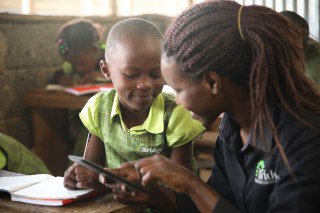How Technology Can Help Underserved Children Learn
Education technology (also known as “edtech”) too often seems like a luxury found only in well-off communities. But while it does have the potential to exacerbate inequities in education, it can actually serve as a great equalizer in improving the quality of education for children in need.
Call it “Equitable Edtech” – digital tools thoughtfully deployed to help close the learning gap for underserved students. Here are three ways edtech is working effectively in low-income markets.
Edtech can help teachers prioritize instruction for those most in need, without raising costs

For centuries, teachers have been expected to design lesson plans, deliver content, keep students engaged, and produce learning outcomes, day in and day out. These expectations are particularly challenging to meet in low-income countries, where teachers often have not had the opportunity or training to master the content they teach. They also face large, overcrowded classrooms with students who might be three to four years behind grade level. However, there is emerging evidence that technology-enabled solutions can help teachers better assess their students’ strengths and weaknesses and target instruction across a diverse classroom effectively. These solutions may have even larger relative benefits for the most underserved students.
For example, in 2013 Uruguay implemented bettermarks, a German-based adaptive learning platform for middle and high school math. It was installed across the entire country’s public school system for the equivalent of only US$1.50 per student per year. The platform provides teachers with an evaluation report for each student so instruction can be tailored to a student’s needs. A 2017 randomized control study by Centro de Investigaciones Económicas demonstrated that sustained usage by Uruguay’s public school students over three years produced increases in math scores by 2.6 standard deviations. The impact of the bettermarks platform could be roughly equated to having two months more of classes over three years, with that effect rising to four months over the same period for lower-income learners (or 1.33 months more classes per school year).
In the Uruguayan case, and in other effective edtech-enabled environments, technology doesn’t replace teachers, but supports them by clearly indicating where each student is on his or her learning path. By collecting and analyzing data on student competencies and gaps, edtech can enable teachers to target instruction more efficiently and effectively.
Edtech can deliver quality content and competency learning to all students
We have come a long way since the highly criticized “One Laptop per Child” that helped shape perceptions about students sitting alone watching screens with limited educational content. Yet, concerns remain about prolonged screen time as well as the educational value of classroom technology
Thankfully, we are now much better informed by years of research about what makes good pedagogy and sound instruction. That learning is now integrated within the best tech-based learning programs. There is robust evidence, for example, regarding project-based learning (PBL) and how collaboration between students on multidisciplinary projects helps improve mastery of content and instills 21st century competencies.
There is now additional evidence that integrating technology to power PBL boosts learning outcomes across income, racial, and ethnic lines. Startups such as Inveno and WhizJuniors, both based in India and focused on teaching coding and computational thinking skills, are adopting a project-based learning approach. Their curriculum combines real-world projects with the study of programming. In case of Inveno, students can run code on a programmable robot. WhizJuniors provides video instruction to students for developing their projects. Both Inveno and WhizJuniors train teachers in their pedagogy. Students store their “portfolios” of projects on a digital platform, where they are assessed and certified.
Edtech can be deployed in lower-resource schools, even those with low connectivity, while improving learning for lower-income students
There is a common claim that edtech only works in higher-income schools with fast broadband internet and highly trained teachers. While such environments certainly present an ideal context, lower-income communities that may have less-prepared teachers and low-to-no connectivity have also successfully implemented edtech solutions with significant results.
Bridge International Academies is a network of schools in some of the most marginalized communities across Africa and India. It uses tech to help deliver high-quality learning. A key element of its model uses tech to provide teachers with continual professional development support and teaching best practices. Bridge’s e-learning platform delivers lesson plans using teacher guides that can work over 2G (which is now available to 95% of the world’s population). That connects all Bridge’s classrooms and allows for real-time data collection of things like teacher attendance, lessons delivered and student performance. No matter how remote the classroom, the tech is delivering results.
Equitable edtech can potentially improve learning opportunities for children throughout the world, including the four billion living in communities with limited internet connectivity. As edtech investors here at Omidyar Network, where we both work, we are driven by UN Sustainable Development Goal number four, aiming to achieve inclusive and quality education for all by 2030. Edtech can be a great equalizer— but at the moment 617 million children and adolescents are leaving school without achieving minimum proficiency levels in reading and math. We need to utilize all tools available, including scalable edtech, to reach students and children most in need.
Amy Klement and Eliza Erikson are partners at Omidyar Network. Both are focused on global education initiatives. Disclosure: Omidyar Network is an investor in Bridge International Academies.